#spectral composition
Text
Steve Lehman & Orchestre National De Jazz — Ex Machina (Pi)

When you think big, there’s no substitute for resources. Alto saxophonist and composer Steve Lehman’s ideas are typically broad and deep, but Ex Machina is especially massive. The project combines big band jazz, spectral composition, and interactive electronics. Any one of these elements takes study and skill to master, and while Lehman has the instrumental chops and integrative intellect grasp the parts, it takes a lot of time in a well-stocked kitchen to assemble them all into something that isn’t just a lumpy influence stew. requires a lot of time in a well-stocked kitchen.
In order to pull off this project, Lehman collaborated with the Orchestre National de Jazz, a big band funded by the French government. He also involved IRCAM (the Institute for Research and Coordination in Acoustics/Musics) to incorporate electronics that respond to the live musicians in real time. After years of composing and workshopping, Lehman and his long-time American collaborators, trumpeter Jonathan Finlayson and vibraphonist Chris Dingham, joined the orchestra for eight concerts, and then settled into the studio for four days at the beginning of 2023.
The time and resources have not gone to waste. This music feels not only sui generis — the only records it really sounds like are Lehman’s earlier octet recordings — but lived-in. The exchanges between dopplering horn sections and single soloists, and the meshing between orchestrated frequencies and precisely mutating rhythms, is spot-on.
But enough about how impressive it is; what is it? Essentially, it’s a transfer of Lehman’s spectral jazz concept, in which an understanding of frequency relationships yields access to alien sounds and an engagement with rhythm concepts spanning the ages of bebop and hip-hop makes the whole thing swing, to a post-Gil Evans orchestral environment. It has plenty of big brass punch, crips rhythms, and abrupt shifts in velocity and tone, all of which create fertile opportunities for adroit soloists to assert both structure-oriented and emotion-evoking responses. Ex Machina is everything it set out to be. And if you’re looking for a recording that’ll give you new things to hear every time you play it, it is without peers.
Bill Meyer
#steve lehman#orchestre national de jazz#ex machina#pi#bill meyer#albumreview#dusted magazine#jazz#big band jazz#electronics#spectral composition#IRCAM#Bandcamp
10 notes
·
View notes
Text
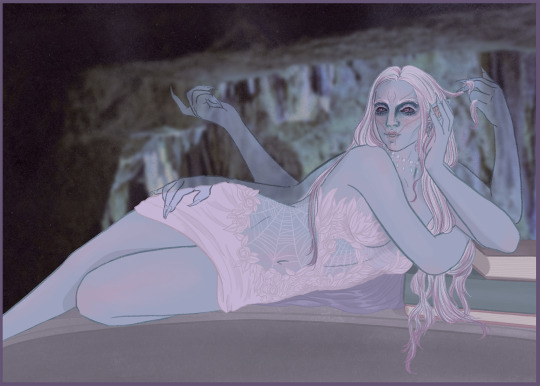

You're in my web now / I've come to wrap you up tight till it's time to bite down
(alternative title: you're part of a fringe feydark-based cult of lolth. one of your fellow members tells you the cult leader wants to see you in her inner sanctum. you get there and she gives you this look. wyd)
#technically she has one more spectral arm but there was just no way I was gonna fit it in the composition and have it look natural ok.#just imagine it's behind her back#bg3 tav#bg3 fanart#bg3#oc: soluwae#pose is inspired by giovanni dupré's urania (goddess of astronomy)#drow#bg3 oc#my art
38 notes
·
View notes
Text
FTIR Spectrometer

Fourier Transform Infrared Spectroscopy (FTIR) is a powerful analytical technique used for identifying chemical compounds and determining their molecular structure based on their interaction with infrared light. High sensitive integrated DLATGS detector.
0 notes
Text

Cosmic latte
"Cosmic latte" refers to the average color of the universe as determined by a team of astronomers led by Karl Glazebrook and Ivan Baldry. In 2002, they conducted a study to determine the color of the universe by combining light from over 200,000 galaxies.
After analyzing the spectral data from these galaxies, the researchers calculated the average wavelength of light and determined that the color of the universe, when viewed as a whole, is a pale beige or light brown. They humorously named this color "cosmic latte" due to its resemblance to the color of milky coffee.
The color was arrived at by combining the light emitted by stars of different ages and colors in the observed galaxies. It represents a composite color that takes into account the distribution and intensity of light throughout the universe.
The discovery of the cosmic latte color provides an interesting perspective on the overall composition of the universe. It indicates that the combination of stars and galaxies across vast distances creates a uniform hue when viewed from a distance.
While the term "cosmic latte" is not an official scientific term, it has gained popularity in popular science discussions and has become a recognizable way to describe the average color of the universe. It serves as a playful and relatable way to conceptualize the vastness and complexity of the cosmos.
Read more
#cosmic latte#color#color theory#color palette#astrology#astronomy#wikipedia#weird facts#weird history#strange facts#strange history#random fact#weird wikipedia#wikiweird
1K notes
·
View notes
Text
Using data from the retired Stratospheric Observatory for Infrared Astronomy (SOFIA)—a joint project of NASA and the German Space Agency at DLR—Southwest Research Institute scientists have discovered, for the first time, water molecules on the surface of an asteroid. Scientists looked at four silicate-rich asteroids using the FORCAST instrument to isolate the mid-infrared spectral signatures indicative of molecular water on two of them.
"Asteroids are leftovers from the planetary formation process, so their compositions vary depending on where they formed in the solar nebula," said SwRI's Dr. Anicia Arredondo, lead author of a paper in The Planetary Science Journal about the discovery. "Of particular interest is the distribution of water on asteroids, because that can shed light on how water was delivered to Earth."
Continue Reading.
122 notes
·
View notes
Text
IS THE MOON RUSTING??
Blog#309
Wednesday, June 28th, 2023
Welcome back,
While our Moon is airless, research indicates the presence of hematite, a form of rust that normally requires oxygen and water. That has scientists puzzled.
Mars has long been known for its rust. Iron on its surface, combined with water and oxygen from the ancient past, give the Red Planet its hue. But scientists were recently surprised to find evidence that our airless Moon has rust on it as well.

A new paper in Science Advances reviews data from the Indian Space Research Organization's Chandrayaan-1 orbiter, which discovered water ice and mapped out a variety of minerals while surveying the Moon's surface in 2008. Lead author Shuai Li of the University of Hawaii has studied that water extensively in data from Chandrayaan-1's Moon Mineralogy Mapper instrument, or M3, which was built by NASA's Jet Propulsion Laboratory in Southern California. Water interacts with rock to produce a diversity of minerals, and M3 detected spectra - or light reflected off surfaces - that revealed the Moon's poles had a very different composition than the rest of it.
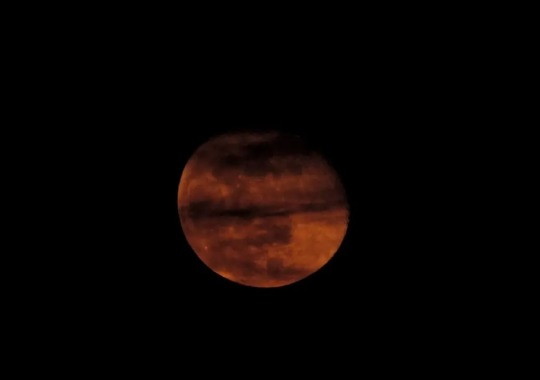
Intrigued, Li homed in on these polar spectra. While the Moon's surface is littered with iron-rich rocks, he nevertheless was surprised to find a close match with the spectral signature of hematite. The mineral is a form of iron oxide, or rust, produced when iron is exposed to oxygen and water. But the Moon isn't supposed to have oxygen or liquid water, so how can it be rusting?
The mystery starts with the solar wind, a stream of charged particles that flows out from the Sun, bombarding Earth and the Moon with hydrogen.

Hydrogen makes it harder for hematite to form. It's what is known as a reducer, meaning it adds electrons to the materials it interacts with. That's the opposite of what is needed to make hematite: For iron to rust, it requires an oxidizer, which removes electrons. And while the Earth has a magnetic field shielding it from this hydrogen, the Moon does not.
"It's very puzzling," Li said. "The Moon is a terrible environment for hematite to form in." So he turned to JPL scientists Abigail Fraeman and Vivian Sun to help poke at M3's data and confirm his discovery of hematite.
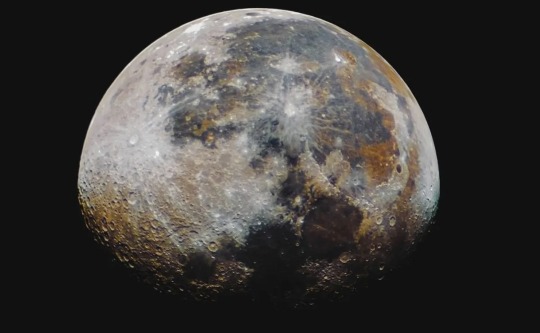
"At first, I totally didn't believe it. It shouldn't exist based on the conditions present on the Moon," Fraeman said. "But since we discovered water on the Moon, people have been speculating that there could be a greater variety of minerals than we realize if that water had reacted with rocks."
After taking a close look, Fraeman and Sun became convinced M3's data does indeed indicate the presence of hematite at the lunar poles. "In the end, the spectra were convincingly hematite-bearing, and there needed to be an explanation for why it's on the Moon," Sun said.
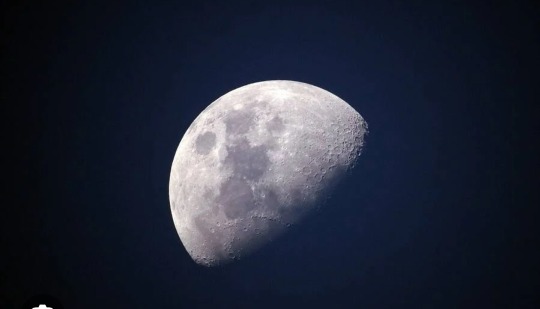
Their paper offers a three-pronged model to explain how rust might form in such an environment. For starters, while the Moon lacks an atmosphere, it is in fact home to trace amounts of oxygen. The source of that oxygen: our planet.
Earth's magnetic field trails behind the planet like a windsock. In 2007, Japan's Kaguya orbiter discovered that oxygen from Earth's upper atmosphere can hitch a ride on this trailing magnetotail, as it's officially known, traveling the 239,000 miles (385,00 kilometers) to the Moon.
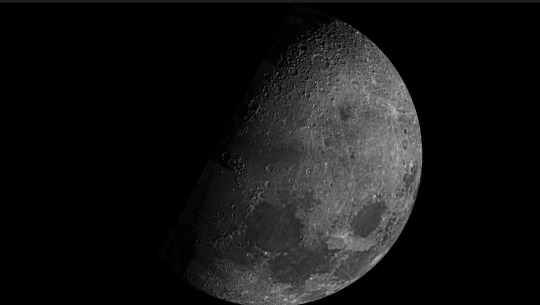
That discovery fits with data from M3, which found more hematite on the Moon's Earth-facing near side than on its far side. "This suggested that Earth's oxygen could be driving the formation of hematite," Li said. The Moon has been inching away from Earth for billions of years, so it's also possible that more oxygen hopped across this rift when the two were closer in the ancient past.
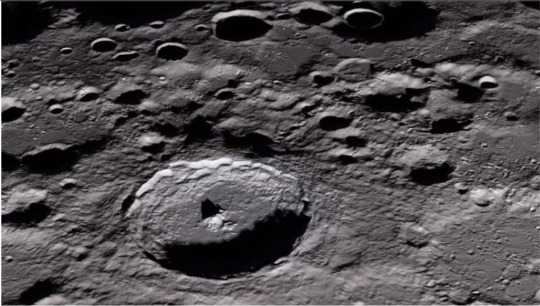
Then there's the matter of all that hydrogen being delivered by the solar wind. As a reducer, hydrogen should prevent oxidation from occurring.
But Earth's magnetotail has a mediating effect. Besides ferrying oxygen to the Moon from our home planet, it also blocks over 99% of the solar wind during certain periods of the Moon's orbit (specifically, whenever it's in the full Moon phase). That opens occasional windows during the lunar cycle when rust can form.
Originally published on NASA.gov
COMING UP!!
(Saturday, July 1st, 2023)
"WHAT IS TIME DISTORTION??"
#atmosphere#astronomy#outer space#alternate universe#astrophysics#universe#spacecraft#white universe#space#parallel universe#astrophotography#moon#rusty moon
206 notes
·
View notes
Photo

Quadrantids of the North : Named for a forgotten constellation, the Quadrantid Meteor Shower puts on an annual show for planet Earth's northern hemisphere skygazers. The shower's radiant on the sky lies within the old, astronomically obsolete constellation Quadrans Muralis. That location is not far from the Big Dipper, at the boundaries of the modern constellations Bootes and Draco. In fact north star Polaris is just below center in this frame and the Big Dipper asterism (known to some as the Plough) is above it, with the meteor shower radiant to the right. Pointing back toward the radiant, Quadrantid meteors streak through the night in the panoramic skyscape, a composite of images taken in the hours around the shower's peak on January 4, 2022. Arrayed in the foreground are radio telescopes of the Chinese Spectral Radioheliograph, Mingantu Observing Station, Inner Mongolia, China. A likely source of the dust stream that produces Quadrantid meteors was identified in 2003 as an asteroid. via NASA
458 notes
·
View notes
Text
Ortho Info Compilation part 2: Abilities
Ortho’s various capabilities change according to his “gear,” which have been mostly (but not all been) designed and crafted by Idia.

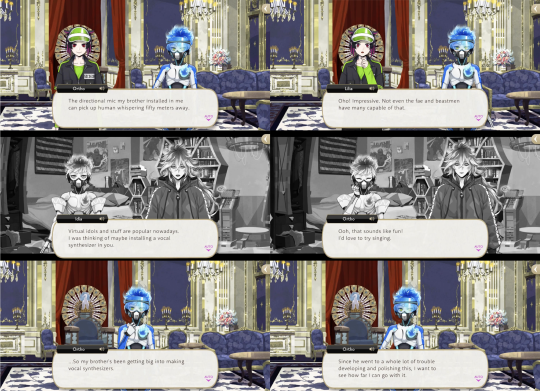

Ortho regularly references the tools and abilities with which he has been equipped, such as:
・a directional mic that can pick up human whispering fifty meters away (better than the hearing of fae and beastpeople, according to Lilia)
・a vocal synthesizer
・LED beams



・projection mapping
・a 4D mode (for olfactory immersion)
・access to the school’s surveillance feeds
・a manual that includes information on “classic date spots”
・weather calculation
・the ability to fly into space
・alloy fibers (“modeled after Jack Howl’s legs”)



・a fiberscope
・mini-arms
・a 3D printer
・a first-aid kit


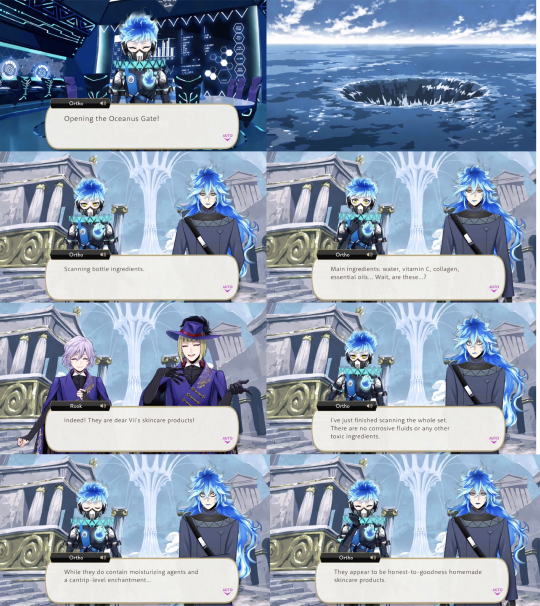
・the ability to detect and describe unseen campus intruders
・the ability to open the Oceanus Gate to STYX
・the ability to scan and identify the composition of objects like skincare products.
Ortho seems to have a “sleep mode,” a “low illumination mode” and an “auto mode.”



Ortho will occasional reference his “databanks,” which is how he is able to recognize the spectral realm during Halloween.
He says they “have a baseline of 100,000 books stored inside” and “include comprehensive data on medicinal herbs and medicines.”
Ortho says he is under order from Idia to never log into satellite position systems, but there does not seem to be anything actually keeping him from doing so.



He can detect people within a 10,000 meter radius (and motion detect within a one-kilometer radius), which he says makes it difficult to sneak up on him.
Ortho is also capable of telling whether or not others are being sincere, testing this ability on Ace, Idia and Rook.
Rook, however, may be capable of fooling Ortho’s tests for heart rate fluctuations, perspiration and other vital signs (during Halloween he tells Trey he is capable of controlling his own heart rate).



Ortho often video records the happenings around him (during so during both Phantom Bride and Spectral Soiree), and he seems to keep chat logs/voice recordings from Idia.
Ortho is also equipped with a “technomantic beam” which he threatens to fire at the school in order to save Idia during Phantom Bride.



He says that his “burst gear” (based on the school’s ceremonial robes) can output it at high levels.
He comes close to firing his technomatic cannon at visitors during the Halloween event and Fairy Gala IF.
Ortho fires his beam at two bullies in a vignette, which may or may not have been with intent to kill: he regrets that they were able to dodge his attack, which wrecks a pillar instead.
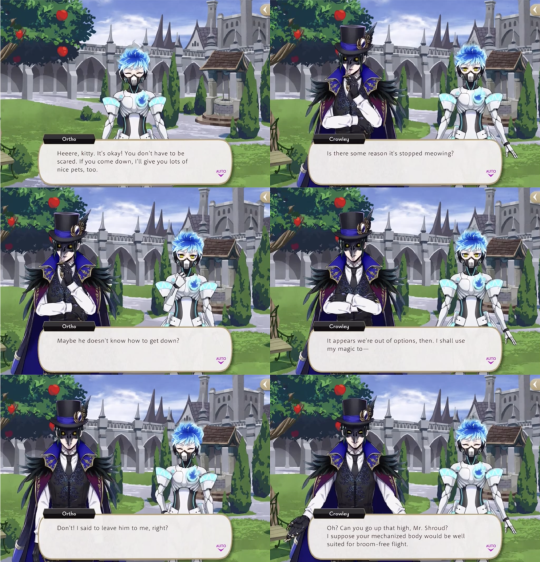


Ortho also fires his beam when trying to help Crowley get Lucius down from a tree, splitting it in half.
(Crowley has a thing for the school’s apple trees, according to both Trey and Ruggie. Epel has a line about how “apple trees can withstand intense cold and still bear fruit.”)

83 notes
·
View notes
Text
Since there won't be any more expansions (and i'm a chronic procrastinator), i updated my personal top 10 Gwent card arts into a top 20, including the few sets that came since then and shuffling things around a bit.
It's a long one, hence the cut.
Personal top 20 Gwent card arts:
20: Bone Talisman by Bogna Gawrońska
It's still the most festive looking thing i like. My beloved blue-and-bright red fidget spinner. I really can't explain my weird attachment to it any other way; i generally tend to like the item arts, maybe it's the collector brain, maybe it's because after Homecoming and most of the expansion sets since later 2019 onwards, these base set trinket adjacent arts became more prominent to me among a lot of new, more dramatic and bleak character and scenery art.

19: Ceremonial Dagger by Katarzyna Bekus
The entire set of strategem arts from Merchants of Ofir is honestly packed, but the dagger is the one i found myself putting in my in-game profile the most. Maybe it's the item hoarder brain again, maybe it's the color scheme i find relatable if that makes sense, most likely it's the premium helping a bunch to make that choice too. The background weirdly fascinates me. Does it have anything to do with The Spiral? I have never attempted to really assign any logical meaning to the strategem arts, they're clearly more symbolic than anything, but it still makes you wonder.
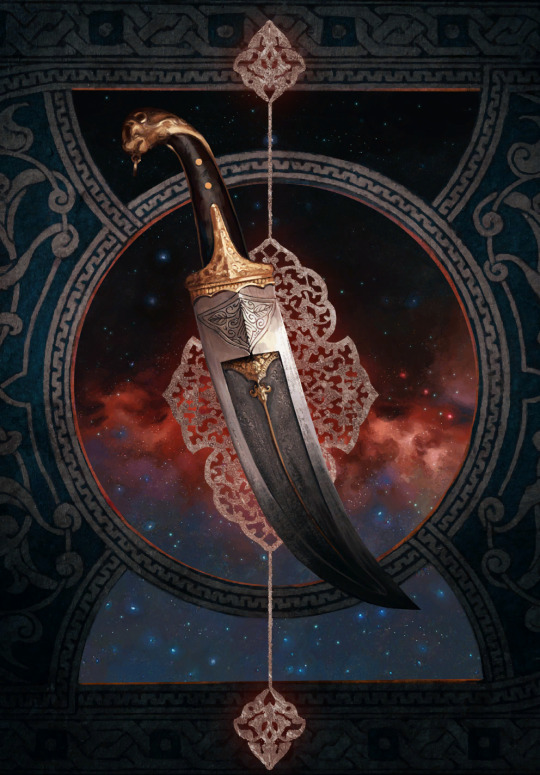
18: Ard Gaeth by Katarzyna Bekus
Somewhat related, here's another piece of wonky multiverse lore. And once again, it's the color that first grabs attention; the contrast of teal and this dusty red. Then one starts realizing the implied size and scope, the birds help with that, apart from being a cute composition detail. The shattery effect makes it look volatile, unstable, dangerous. Ominous. Which ultimately makes it fit with the rest of the Wild Hunt archetype in more than just lore.
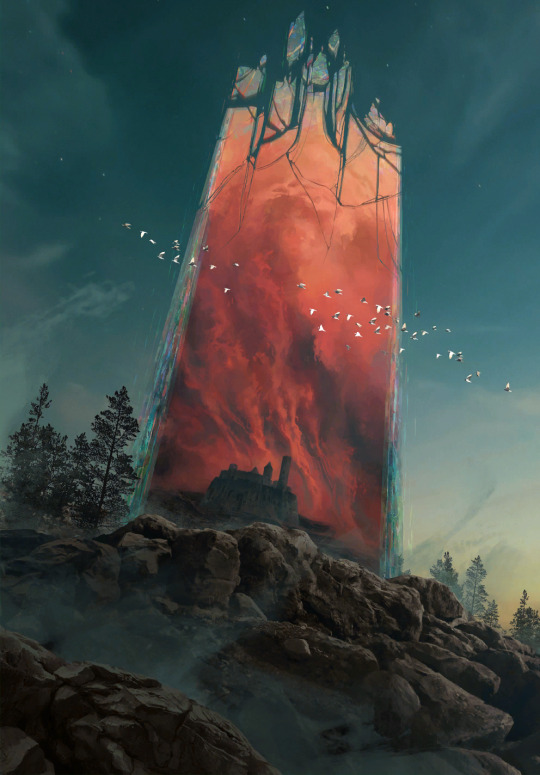
17: Coup de Grâce by Lorenzo Mastroianni
There are two wolves in me, one loves bright colors, the other actually enjoys a lot of the bleaker scenes. Although to be fair, Lorenzo Mastroianni is a big contributor to that. And it's no wonder, when he casually drops stuff like this. It's almost symbolic, lot less than strategems but certainly more than other, straightforward "war sucks" Gwent art. How do you visually represent something sad in a way that makes it hard to look away not just because of the tragedy but because of the beauty put into making that image?
You ask Lorenzo Mastroianni, the modern classical artist, to do it.
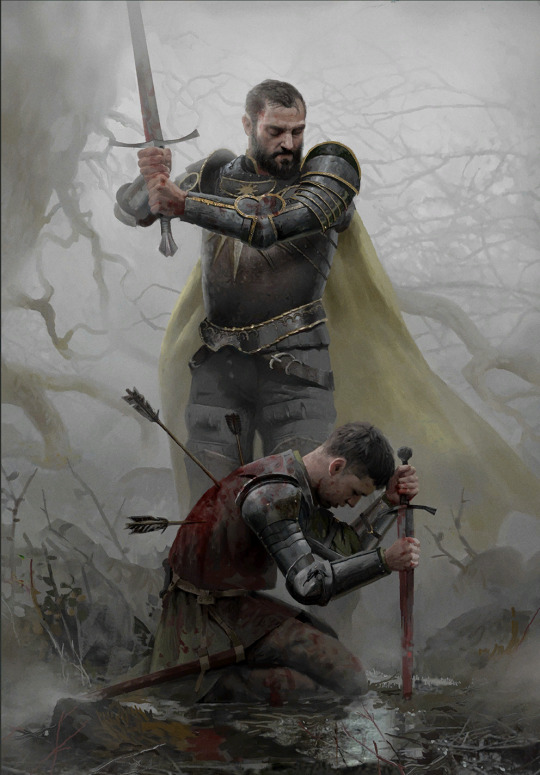
16: Viper Witcher by Valeriy Vegera
I once described Valeriy's art as "where Lorenzo uses a tight color palette, he uses every pencil in the case". This one is perhaps not as obvious an example, the whole piece has a very unified atmosphere especially from afar, but still, there are so many colors especially in textiles and skin. They're harder to register sometimes but it's how Valeriy does texture and shading. And somehow, he bridges the bleak and the colorful world too. Admittedly, this card also had to be here because mr. Viper is my son, and the voicelines are done by an actor with the nicest, smoothest bass i've heard since Peter Steele.
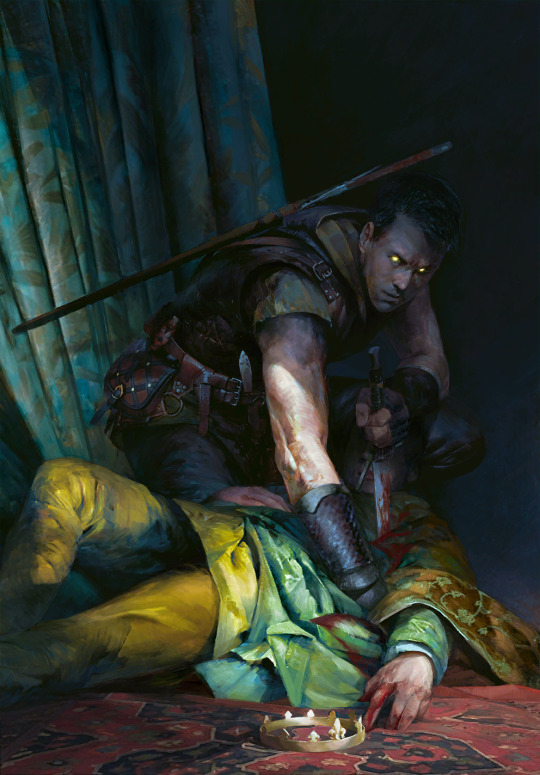
15: Naglfar's Crew by Anton Nazarenko
I was surprised by how much i ended up liking this one. It's the implications, i think; enchanted to laboriously upkeep this monster of a ship, this 'and if you see it emerge from a breach in the sky, you know you're fucked' symbol of death and decay. It's dark in a way i find compelling, i guess.

14: Serpent Trap by Marta Dettlaff
Back to the bright ones, i liked this art ever since i discovered it as Nature's Gift in post-Midwinter beta. The card saw play in Scoia'tael spell decks, and to me it became linked to Francesca Findabair for their shared spectral snake thing. But that all aside, the art is just so pretty. Vibrant, yet not oversaturated. And like the item arts, needed to balance out the cool and badass and the dramatic and tragic. Looking at it now, another point comes to mind; it's still grounded? The way Gwent art at large is grounded compared to other card games. Like it's not trying so hard (both this piece and the game's art in general). That's refreshing.

13: Chort by Bartłomiej Gaweł
It reminds me of the first game's main menu. The Witcher 1 main menu is, to me, one of the most accurate representations of this universe, its atmosphere. Even if the "you kill cows, you get ambushed by the fucking baphomet" is a meme game mechanic, something about it is...witchery. Superstition, folk legends, and ultimately, monsters. Or that's my takeaway, anyway. But the Chort art, beside being on the more rare side in-game, has always weirdly drawn me in.

12. Oneiromancy by Lorenzo Mastroianni
This was the Novigrad expansion key art before they turned it into a card, and i sure am glad they did. Lorenzo can get a bit weird, as a treat, someone said. Are they Condwiramurs and Corinne? Possibly! But i'll abstain from the schizo theories now. It's a gorgeous, well composed and executed surrealist piece. Inception if it had strong palpable atmosphere.

Denis Villeneuve > Christopher Nolan. but Lorenzo beats both
11: Funeral Boat by, you guessed it, Lorenzo Mastroianni
One final yippee for the last card set. And my god it's beautiful. Tight composition can get surprisingly hard to coordinate and make decisions for, but this is so well-balanced. The left end of the boat is closer to the frame, but right side has the most noticeable color, the character's face, and of course the bird to even it out.
As if to defend the title i gave him earlier, Lorenzo references Isle of the Dead in a way that, even if symbolic, fits into the universe perfectly. Someone stop me before i start rambling about similar concepts in different mythologies.
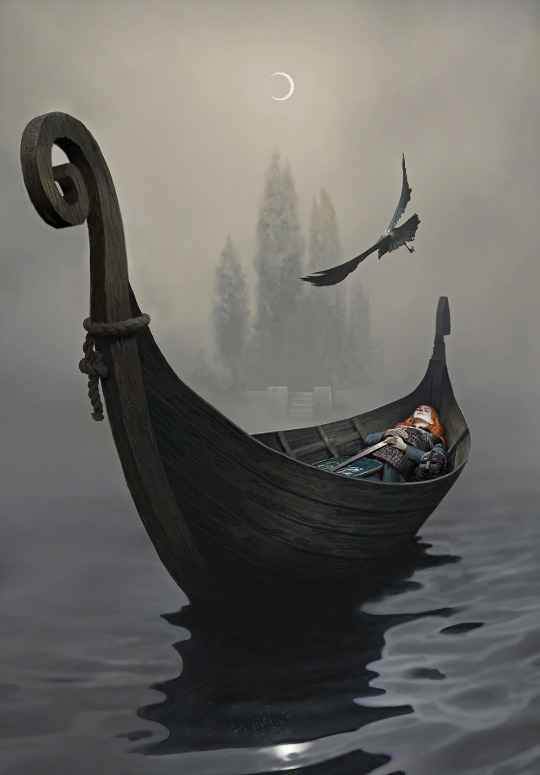
10: Dana Méadbh (now the token spawned by Call of Harmony) by Anna Podedworna
The most famous Gwent artist enters the list. With a piece made around two, when you think about it very bold choices. The goddess of nature and life, glowing with inhuman light in a black and barren forest. Obscured by thin, bare tree trunks. But to make her emerge and stand out, that was necessary. And it's working wonders. A lot of the Scoia'tael faction is obviously green, all kinds of green, but even a simple choice like making it pop out of black makes the card art stand out among others.
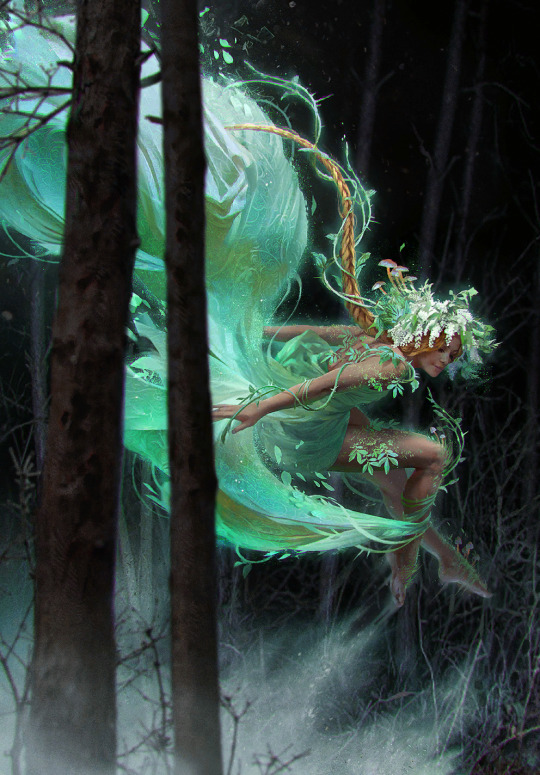
9: Circle of Life by Oleksandr Kozachenko
It has everything i usually look for in Gwent art; nature, color, atmosphere. A certain tranquility, perhaps. A little bit of story - the orange badge is the Kerack coat of arms. It's that environmental storytelling thing gamers keep talking about, complementing the character and faction drama of the rest of its card set.

There's a slightly changed, extended version, too, and somehow it's even better.
8: Gezras of Leyda by Bogdan Rezunenko
As much as i tend to dunk on Bogdan for having played Blasphemous once and making it his entire personality, Gezras is easily the best school founder card art of the set. Once again, the choice to have these prominent arts on the more symbolic side paid off, and the result is a stalking nocturnal animal out for revenge, backed by a giant image of what simultaneously did him irrepairable harm and gave him the means to defend himself. The premium doesn't disappoint either.

7: Rioghan the Undying by Daniel Valaisis
To nobody's surprise, the atmosphere, once again, got me hooked. I love the cold color, the dramatic flow, the big imposing silhouette of a ship in the background. Poor boy is the picture of misery. It's pure melancholy (something not that common in the Skellige faction by the way, which is a point in favor of Funeral Boat too), that i, of course, am inevitably drawn to.

he's just like me fr...
6: Witches' Sabbath by Michal Lisowski
Did i craft this card already or not? The realist's complaint towards near-greyscale card art. I share this sentiment, if only for the comedy of it, but with a few notable exceptions, and this piece is the main one. The Robert Eggers comparisons were made already i'm sure, but it really is a take on the last good Witcher 3 quest with a dramatic, more dreamy, or you could say cinematic quality ramped up to 11. Gone is the fanservice present in the game and the unnecessarily grotesque depictions of fatness of other parts of this card set, and what remains is a beautiful, ominous callback to folklore and classical art.
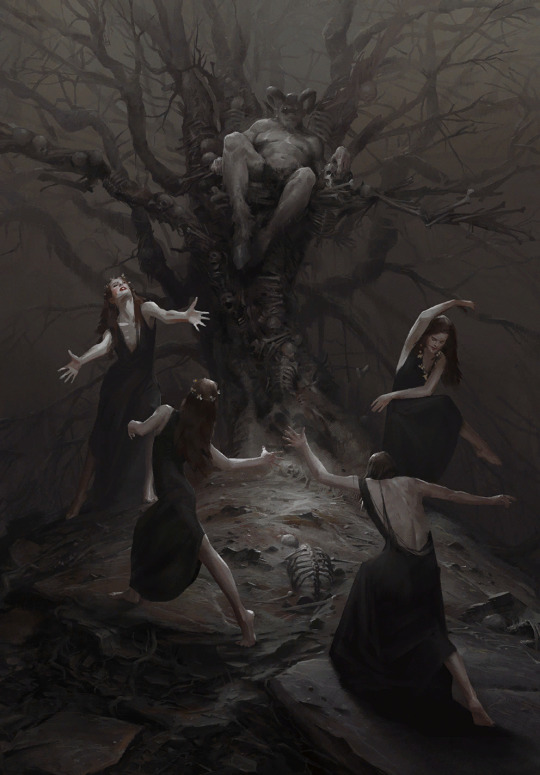
5: Tinboy by Valeriy Vegera
This is a baroque painting. The drama. Tinboy doesn't take that scarf off, ever. And here this poor soul is, their last will to live dragging it off him. On purpose? On accident? Probably both. The pattern marking Tinboy as a gang member staining with blood of a victim, something something symbolism. All in Valeriy's signature 'which pencil should i pick up next' style. Underrated piece.
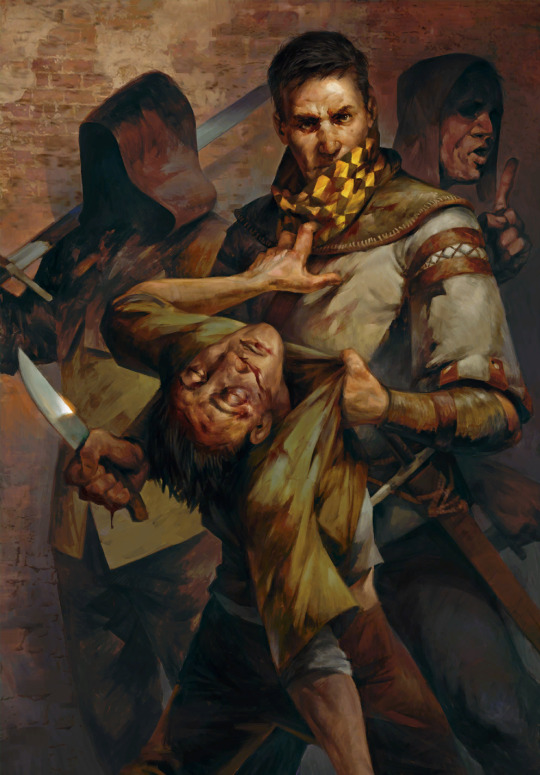
4: Lara Dorren by Toni Muntean
They finally got our girl. And once again, despite heartbreak, it's gorgeous. Soft, sweet colors with a necessary hint of melancholy (the lighting suggests it's sunset?), and a pure, painted quality without the need for texture assets. A scene like this is better left a comparatively simple and laid back tribute. Beyond the technicalities, i also really, really applaud Toni for the outfit design. This is the Aen Elle princess, dressed well but for the weather. And the fact her mostly blue clothes with yellow sleeves mirror Cregennan's yellow jerkin with blue details, and her red brooch above the heart might, beside contrasting with the blue, very well reflect his fatal wounds... well.
As much as death on card art isn't always done the best, Lara is represented together with that which mattered to her the most. Despite being categorized among the Wild Hunt, she remains herself.
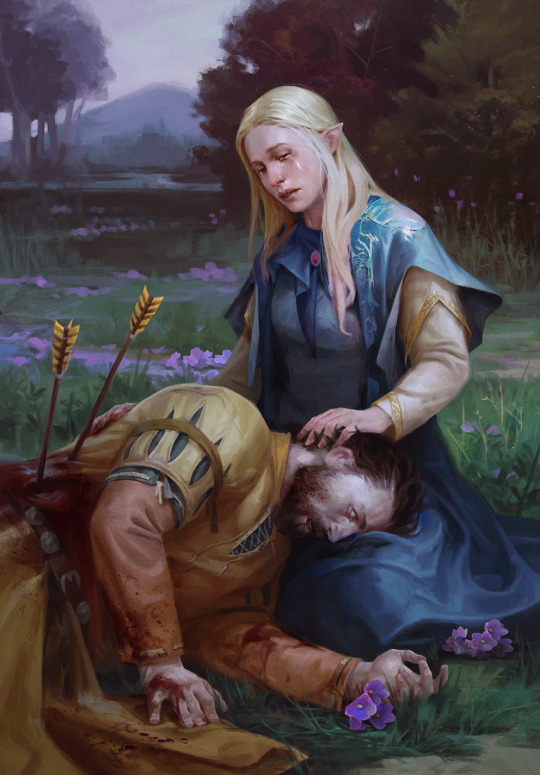
3: Lydia van Bredervoort by Igor Klymenko
The joy i felt when this was the art of Lydia they managed to get into the game. It's easily one of the best contest pieces and on par with the best Gwent has to offer - it has mood, and that ever present air of groundedness, realism, and in that, unfortunate tragedy. But similarly to Lara, it shows Lydia being her own person; doing what she loved and was good at without sight of Vilgefortz despite her being known as his ever loyal assistant. Likewise, it doesn't sensantionalize her condition, but references it in a subtle, tasteful, and even clever way. I also love her dress and the overall color palette. Igor understood.
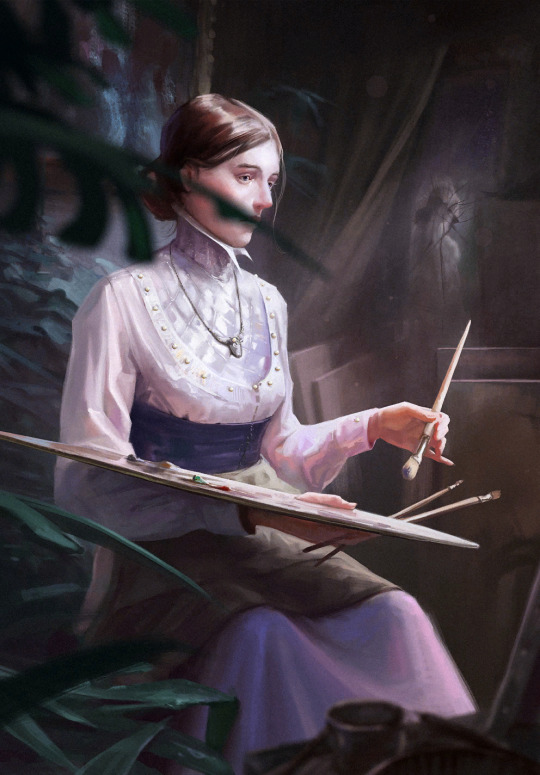
2: Eldain by Anna Podedworna
Couldn't help it, this asshole has me in chokehold and he's enjoying it. In my defense, this piece highlights everything Anna is known for, because she's damn good at it. Incredibly sharp main subject of the piece contrasted against a blurry background, which allows for insane details like the strings extending from the top of the lute. To add more fun to it, Eldain isn't even in the absolute foreground, but the piece is still composed smart, so he remains the main focus. His silly red collar on mostly green helps. On top of all that, the art tells a little story, something Anna often does too, and in this case it delightfully sums Eldain up. It's also the best premium in the game.
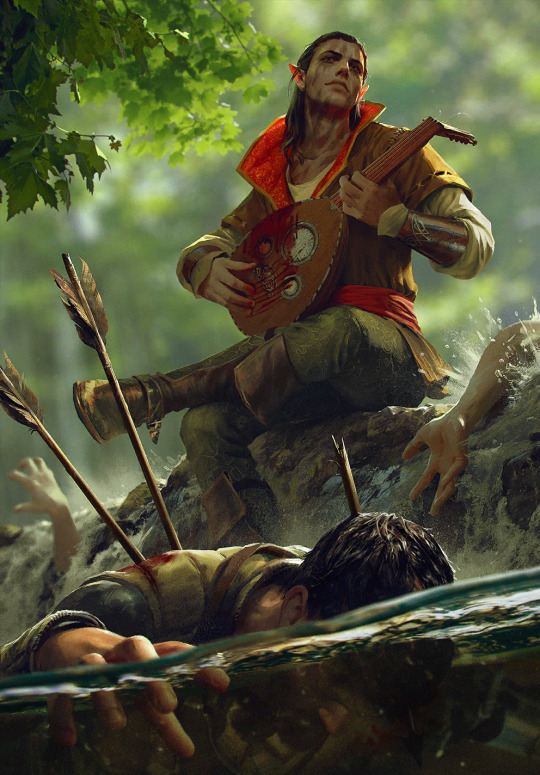
look at his little red ears from sitting against the sun aww
Honorable mention: Lake Guardian by Anton Nazarenko
Like the following #1, this card has sentimental value to me as my second card reveal and artwork i made my best emote of. It was a perfect match, bird gals and all. It's a Sirin, bringing in a more obscure but not unwelcome mythology reference to the universe. And I love her vibrant, marble-like eyes.

1: Dol Blathanna Sentry by Lorenzo Mastroianni
...remains my favourite card art since that fateful day sometime in January 2018.
I was just discovering what there was to know about Witcher, downloading Gwent in the first place out of need for more content as i was slowly reading through the first book. Gwent has done a lot to explore and build on this universe, and it has helped me contextualize a lot of things early on. I remember scrolling through the deckbuilder, seeing this art, and being struck by its mood, this aura of secret and wonder. "Oh, so this is what Dol Blathanna looks like..."
It's quintessential older Lorenzo. Very much admitted brush work, fog, tight color palette. The little specks of blue in flowers and face paint work just right. Maybe it's a reference to Arthurian myth and Avalon, maybe to Greek myth and Hades, or maybe, as is often the case and was the case later (or earlier in this list), both.
It spoke to me and my sense of wonder back then. It speaks to me when i search for comfort now.
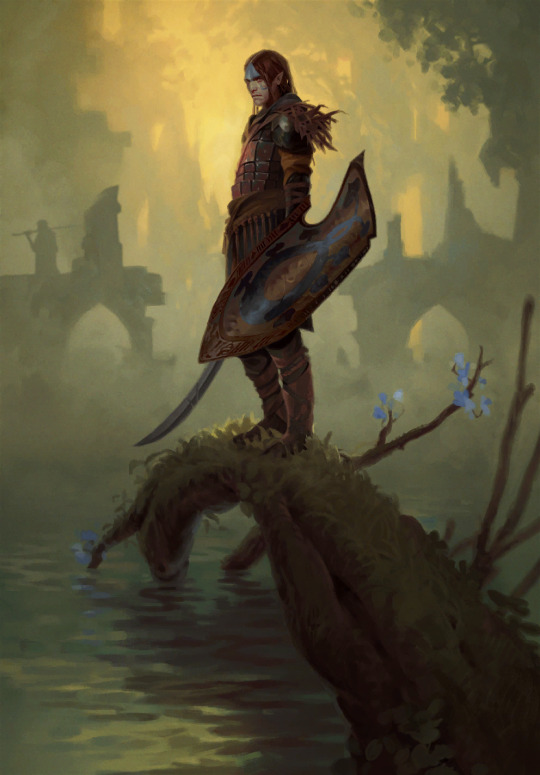
now, time to tear Karol Bem to shreds in the top 20 least favourites xd
#shut up elis#the witcher#gwent: the witcher card game#fingers crossed tungle doesn't obliterate the links
24 notes
·
View notes
Text
Kali Malone - All Life Long
Kali Malone's anticipated new album "All Life Long" is a collection of music for pipe organ, choir, and brass quintet composed by Kali Malone, 2020 - 2023. Choral music performed by Macadam Ensemble and conducted by Etienne Ferschaud at Chapelle Notre-Dame-de-L'Immaculée-Conception in Nantes. Brass quintet music performed by Anima Brass at The Bunker Studio in New York City. Organ music performed by Kali Malone and Stephen O’Malley on the historical meantone tempered pipe organs at Église Saint-François in Lausanne, Orgelpark in Amsterdam, and Malmö Konstmuseum in Sweden.
Kali Malone composes with a rare clarity of vision. Her music is patient and focused, built on a foundation of evolving harmonic cycles that draw out latent emotional resonances. Time is a crucial factor: letting go of expectations of duration and breadth offers a chance to find a space of reflection and contemplation. In her hands, experimental reinterpretations of centuries-old polyphonic compositional methods become portals to new ways of perceiving sound, structure, and introspection. Though awe-inspiring in scope, the most remarkable thing about Malone’s music is the intimacy stirred by the close listening it encourages.
Malone’s new album All Life Long, created between 2020 - 2023, presents her first compositions for organ since 2019’s breakthrough album The Sacrificial Code alongside interrelated pieces for voice and brass performed by Macadam Ensemble and Anima Brass. Over the course of twelve pieces, harmonic themes and patterns recur, presented in altered forms and for varied instrumentation. They emerge and reemerge like echoes of their former selves, making the familiar uncanny. Propelled by lungs and breath rather than bellows and oscillators, Malone’s compositions for choir and brass take on expressive qualities that complicate the austerity that has defined her work, introducing lyricism and the beauty of human fallibility into music that has been driven by mechanical processes. At the same time, the works for organ, performed by Malone with additional accompaniment by Stephen O’Malley on four different organs dating from the 15th to 17th centuries, underscore the mighty, spectral power that those rigorous operations can achieve.
#Kali Malone#organ#choir#brass#drone#sweden#2024#minimalism#modern classical#macadam ensemble#anima brass#Bandcamp
19 notes
·
View notes
Text

MWW Artwork of the Day (11/8/23)
Auguste Rodin (French, 1840–1917)
Orpheus and Eurydice (1893)
Marble sculpture, 123.8 x 79.1 x 64.5 cm.
The Metropolitan Museum of Art, New York (Gift of Thomas F. Ryan)
The mythical poet Orpheus braved the underworld to rescue his dead wife, Eurydice. The gods allowed her ghost to follow him and regain life, provided that Orpheus did not look at her until both had reached the sunlit earth. Rodin depicts Eurydice’s spirit floating in the underworld’s dark entrance while Orpheus hesitates at the threshold. Because he cannot feel her phantom embrace, or hear her spectral voice, Orpheus turns to see if his beloved has come. An instant later he will glimpse her, and Eurydice will vanish. This exquisitely carved sculpture, one of the first Rodin works to come to America, is the only marble example of the composition.
42 notes
·
View notes
Text
James Webb Space Telescope detects water vapor, sulfur dioxide and sand clouds in the atmosphere of a nearby exoplanet
A team of European astronomers, co-led by researchers from the Institute of Astronomy, KU Leuven, used recent observations made with the James Webb Space Telescope to study the atmosphere of the nearby exoplanet WASP-107b. Peering deep into the fluffy atmosphere of WASP-107b they discovered not only water vapour and sulfur dioxide, but even silicate sand clouds. These particles reside within a dynamic atmosphere that exhibits vigorous transport of material.
Astronomers worldwide are harnessing the advanced capabilities of the Mid-Infrared Instrument (MIRI) aboard the James Webb Space Telescope (JWST) to conduct groundbreaking observations of exoplanets – planets orbiting stars other than our own Sun. One of these fascinating worlds is WASP-107b, a unique gaseous exoplanet that orbits a star slightly cooler and less massive than our Sun. The mass of the planet is similar to that of Neptune but its size is much larger than that of Neptune, almost approaching the size of Jupiter. This characteristic renders WASP-107b rather ‘fluffy’ when compared to the gas giant planets within our solar system. The fluffiness of this exoplanet enables astronomers to look roughly 50 times deeper into its atmosphere compared to the depth of exploration achieved for a solar-system giant like Jupiter.
The team of European astronomers took full advantage of the remarkable fluffiness of this exoplanet, enabling them to look deep into its atmosphere. This opportunity opened a window into unravelling the complex chemical composition of its atmosphere. The reason behind this is quite straightforward: the signals, or spectral features, are far more prominent in a less dense atmosphere compared to a more compact one. Their recent study, now published in Nature, reveals the presence of water vapour, sulfur dioxide (SO2), and silicate clouds, but notably, there is no trace of the greenhouse gas methane (CH4).
A dynamic atmosphere
These detections provide crucial insights into the dynamics and chemistry of this captivating exoplanet. First, the absence of methane hints at a potentially warm interior, offering a tantalising glimpse into the movement of heat energy in the planet’s atmosphere. Secondly, the discovery of sulfur dioxide (known for the odour of burnt matches), was a major surprise. Previous models had predicted its absence, but novel climate models of WASP-107b’s atmosphere now show that the very fluffiness of WASP-107b accommodates the formation of sulfur dioxide in its atmosphere. Even though its host star emits a relatively small fraction of high-energy photons due to its cooler nature, these photons can reach deep into the planet’s atmosphere thanks to its fluffy nature. This enables the chemical reactions required to produce sulfur dioxide to occur.
But that's not all they've observed. Both the spectral features of sulfur dioxide and water vapour are significantly diminished compared to what they would be in a cloudless scenario. High-altitude clouds partially obscure the water vapour and sulfur dioxide in the atmosphere. While clouds have been inferred on other exoplanets, this marks the first instance where astronomers can definitively identify the chemical composition of these clouds. In this case, the clouds consist of small silicate particles, a familiar substance for humans found in many parts of the world as the primary constituent of sand.
"JWST is revolutionising exoplanet characterisation, providing unprecedented insights at remarkable speed," says lead author Prof. Leen Decin of KU Leuven. "The discovery of clouds of sand, water, and sulfur dioxide on this fluffy exoplanet by JWST's MIRI instrument is a pivotal milestone. It reshapes our understanding of planetary formation and evolution, shedding new light on our own Solar System."
In contrast to Earth’s atmosphere, where water freezes at low temperatures, in gaseous planets reaching temperatures around 1000 degrees Celsius, silicate particles can freeze out to form clouds. However, in the case of WASP-107b, with a temperature of around 500 degrees Celsius in the outer atmosphere, traditional models predicted that these silicate clouds should be forming deeper within the atmosphere, where temperatures are substantially higher. In addition, sand clouds high up in the atmosphere rain out. How is it then possible that these sand clouds exist at high altitudes and continue to endure?
According to lead author Dr. Michiel Min: "The fact that we see these sand clouds high up in the atmosphere must mean that the sand rain droplets evaporate in deeper, very hot layers and the resulting silicate vapour is efficiently moved back up, where they recondense to form silicate clouds once more. This is very similar to the water vapour and cloud cycle on our own Earth but with droplets made of sand." This continuous cycle of sublimation and condensation through vertical transport is responsible for the enduring presence of sand clouds in WASP-107b's atmosphere.
This pioneering research not only sheds light on the exotic world of WASP-107b but also pushes the boundaries of our understanding of exoplanetary atmospheres. It marks a significant milestone in exoplanetary exploration, revealing the intricate interplay of chemicals and climatic conditions on these distant worlds.
“JWST enables a deep atmospheric characterisation of an exoplanet that does not have any counterpart in our Solar System, we are unravelling new worlds!”, says lead author Dr. Achrène Dyrek at CEA Paris.
Design and development of the MIRI instrument
Thanks to funding by the Belgian federal science policy office BELSPO via the ESA PRODEX programme, Belgian engineers and scientists played a key role in the design and development of the MIRI instrument, including the Centre Spatial de Liege (CSL), Thales Alenia Space (Charleroi) and OIP Sensor Systems (Oudenaarde). At the Institute of Astronomy at KU Leuven, instrument scientists tested the MIRI instrument extensively in special test chambers simulating the space environment in laboratories in the UK, at NASA Goddard and NASA Johnson Space centres.
“With colleagues across Europe and the United States we have been building and testing the MIRI instrument for almost 20 years. It is rewarding to see our instrument unravel the atmosphere of this intriguing exoplanet,” says instrument specialist Dr. Bart Vandenbussche of KU Leuven.
This study combines the results of several independent analyses of the JWST observations, and represents the years of work invested not only in building the MIRI instrument but also in the calibration and analysis tools for the observational data acquired with MIRI,” says Dr. Jeroen Bouwman of the Max-Planck-Institut für Astronomie, Germany.
More information
These observations were taken as part of the Guaranteed Time Observation program 1280.
The James Webb Space Telescope is the world’s premier space science observatory. Webb is solving mysteries in our solar system, looking beyond to distant worlds around other stars, and probing the mysterious structures and origins of our universe and our place in it. Webb is an international program led by NASA with its partners, ESA (European Space Agency) and the Canadian Space Agency.
The European consortium team consists of 46 astronomers from 29 research institutions across 12 countries. From the KU Leuven, the team includes Leen Decin, Thomas Konings, Bart Vandenbussche, Ioannis Argyriou and Linus Heinke.

Peering deep into the fluffy atmosphere of WASP-107b a team of European astronomers discovered not only water vapour and sulfur dioxide, but even silicate sand clouds. CREDIT Illustration: LUCA School of Arts, Belgium/ Klaas Verpoest (visuals), Johan Van Looveren (typography). Science: Achrène Dyrek (CEA and Université Paris Cité, France), Michiel Min (SRON, the Netherlands), Leen Decin (KU Leuven, Belgium) / European MIRI EXO GTO team / ESA / NASA
25 notes
·
View notes
Text
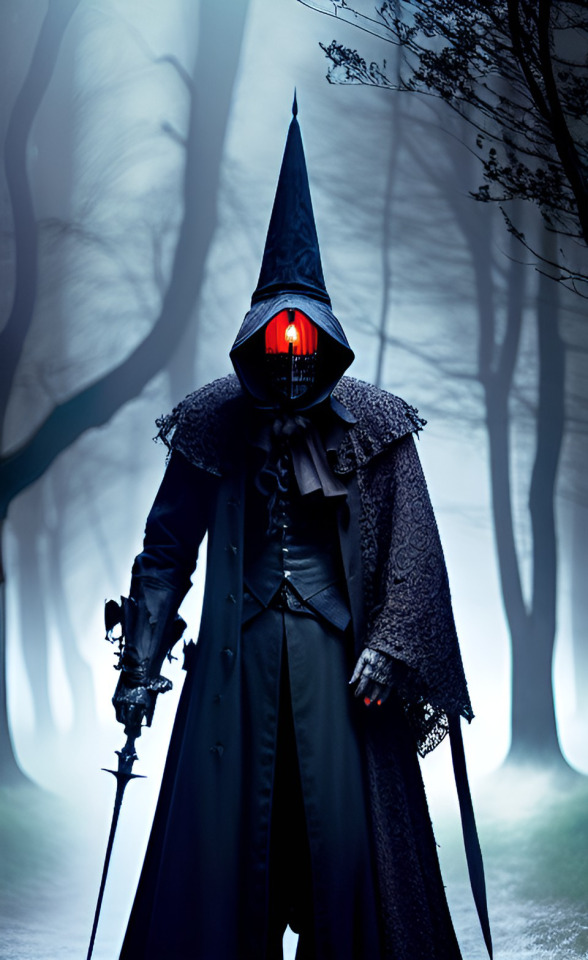
“A young man who was fortunate enough to have survived an alleged encounter with the fabled Lanternhead allowed me to probe his memory (I assure you it was painless) to form a composite image of the spectral entity. While subject to the young man’s capacity to interpret the ethereal I believe this is close to what he may have witnesses…”
#creative writing#fantasy world#conworld#worldbuilding#arkera#world building#low fantasy#high fantasy#dark fantasy#pulp fantasy#historical fantasy#weird fiction#sword & sorcery#cosmic horror#dungeons and dragons#role playing games#dune#conan#a song of ice and fire#game of thrones#lord of the rings#world of darkness#warhammer fantasy#warhammer 40k#bloodborne#dark souls#dragon age#fullmetal alchemist#the dark tower#malazan
110 notes
·
View notes
Note
hi remy :) you remember the post i reblogged from you about the piano :) ? i wrote a little something for you about it :)
He cannot scream. His mouth is sewn shut. He doesn't like to go through the house proper, lest Solomon catch sight of the boy he refuses to truly see.
He cannot play the other instruments. His fingers drip with weak sparks that fizzle out at once. His spectral hands phase through, and the sparks do not catch the wood. The only thing he can touch are the things made of silver, and Solomon makes sure to keep none of them within reach. (He will love running his ghostly fingers over the shoulders of a jacket, silver studding the black like stars, in the place of holding the hands of the person who wears it, but that will come later. In these moments, this wraith of a boy has very little hope for the future.)
He doesn't even know what would happen if he could play the other instruments, anyway. He doesn't know who else is trapped down with him in the basement, and he doesn't know what he'd say if he spoke through the threads to the woman in the fife. Surely nothing good. The entire interaction would make his situation doubtlessly worse, and any catharsis he might get would be muted by the immaterial stitches swallowing his screams.
It is fitting, perhaps, that the only instrument he can play is the one that he is tethered to. The wires circling his wrists lead him towards the ivory keys made with his bones, and they give way beneath his fingers. He cannot press them hard, just enough to make a whisper of a noise before his fingertips slip through. He plays the refrain of one of his old favorite songs. It has been so long, he can no longer remember the words, couldn't sing them even if he was able to speak. He has tried to scorch away the name that never belonged to him staring mockingly from above the keys, to rip out the gold inlay haunting him, but his sparks are too frail and dim, and gold is not silver.
(ad dolor puerum, aurum non est argentum. He can pretend, when his pale luminescence falls upon the lettering, but it will not change its composition.)
One day, when Solomon is gone, a group of thieves enter the house, and among other things, they haul away the piano. He does not know why they chose a grand piano, of all things to steal, but it is being stolen nonetheless. They put his piano inside a different house, one that is slowly decaying, and he fights and he rages and he aches to be given help, a release, 𝘢𝘯𝘺𝘵𝘩𝘪𝘯𝘨, but his presence only fills the people in the house with fear, and it drives them out once they figure out they cannot exorcise him without destroying the piano. He burns, wreathed in white fire before their eyes in a final desperate attempt, and they begin to pack up and leave. In his anger, his sparks grow brighter, and he drags his hands across the peeling wallpaper, scorching the words '𝘭𝘦𝘵 𝘮𝘦 𝘨𝘰, 𝘭𝘦𝘵 𝘮𝘦 𝘨𝘰, 𝘭𝘦𝘵 𝘮𝘦 𝘨𝘰' over and over until a furrow in the wall appears, sunken and charred, and he is alone in the unfamiliar house. There was a reason he had learned to hide his emotions.
He waits, and he waits, until a new figure appears in the doorway, clawed and tall and glancing curiously with blank white eyes, until they see him, and immediately spread their claws defensively. Even as they lower their claws, seemingly transfixed, he remains on guard. When they lay eyes on the piano, however, they cry out and collapse, blank eyes closed. When they awake, he does his best to explain his predicament to them, trying to convey that the word mocking him from its perch above the keys is not his name at all, and that they should destroy the piano. They reach out to the keys, plinking out a refrain from a song he never got the chance to hear, a faraway look in their eyes. They focus back on him, and express apologies for disturbing him, and gladness to have come across him. They have not yet seen a single other soul on their travels. They attempt to cut the threads across his mouth with their black-tipped claw, and the spectral boy isn't sure how much more his emotions can take when it doesn't work. He mimes a request to destroy the piano, hoping that they're as strong as they look, and will be able to get rid of it easier than his dim sparks and shining hands. Despair rises as he thinks they will refuse, but, if his knees were corporeal, they would grow weak with relief when they agree to send him into nothingness.
The revenant sets the piano alight, and pain wracks his stolen, incorporeal bones as gold and red and, at last, hollow black fill his vision.
He awakens, feeling a tugging on his wrists. He is floating, as he usually does, above the ground. He is in a forest, and the wires flowing from his wrists trail from the revenant's pocket, where he knows a single piano key rests. The revenant does not seem to know he is there, and he isn't sure what to feel. He still exists, the pale-eyed revenant hadn't fully destroyed the piano like they had said they would, but, they seem nice. Kind. They had helped him, and he wasn't stuck in a house anymore. He is as free as he is likely to get anytime soon. And suddenly, the revenant is surprised by two creatures, antlered and hooved, and now their arm is halfway across the clearing, and they seem so small in the face of the things intent on ripping them apart at the seams. He cannot let this happen, for his own sake and theirs. He glows, rising behind them, wreathed in burning white that drives the creatures away. They are surprised and apologetic that they unknowingly kept him tethered to them, but he finds himself stopping them. He cannot see their face for all their long, matted hair, but he thinks he would like to. He would like to get to know this strange, wandering person further. Perhaps they can play a refrain together. The piano key's destruction will wait.
Percy Reed knows three things. The first is that his name is Percy Reed, no matter what a certain instrumentalist would say.
The second is that he is dead, but that he has found a person worth living for.
The third is that he is free, from the piano, from the name that was never his, from the man who once was called his father. He still cannot scream, but he has far less reasons to do so, as he grows to love running his fingers over silver studded like stars on the shoulders of a black jacket, and to love the person wearing it, whose hands he cannot yet hold.
Mx. Corvus this was absolutely world shattering tysm for gracing my inbox with this 🫶🫶 I love them so much it’s not even funny-
#remy rambles#asks answered#hiii Corvus!!!!!#hfth#hello from the hallowoods#save#I love this so much /gen#percy reed#diggory graves
13 notes
·
View notes
Text
I want to make a post about this just because
Pelo is currently holding a charity livestream for the Nariz Roja foundation!
youtube
Nariz Roja is a Mexican foundation dedicated to helping low income families in Mexico that have been affected by cancer (according to their website). You can donate here if you're able
The stream is various music compositions made by different artists, set to a loop of Skid and Pump watching a movie
The songs are:
Spectral Strut (Scary Swings remix)
Streber's Lament (Friendly Nightmares remix #1)
It's Spooky Day! (original)
Yesterday's Tomorrow (Tomorrow remix)
Pumpkins and Skeletons (original)
Frightful Daydreams (Friendly Nightmares remix #2)
The Chill (The Thrill remix)
A Real Vampire! (A "Real" Vampire remix)
Don't Knock on That Door (original -- the video calls it "Don't Knock on the Door")
HatzGhouls (Hatzgang remix)
Bumps in the Attic (The Attic Atrocity remix)
Crimson Lake (original)
Pumpkin Clock (original)
17 notes
·
View notes
Text
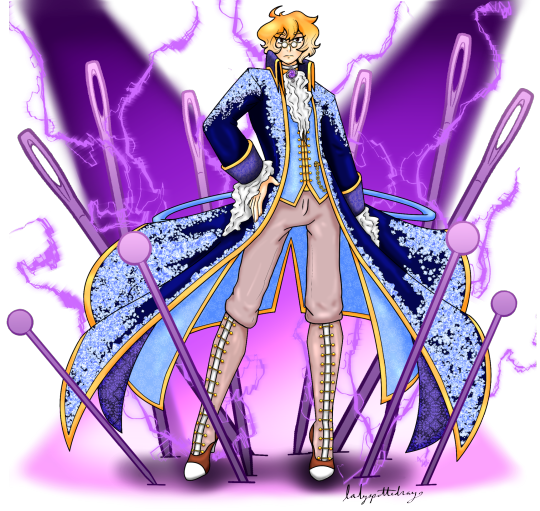

"Clothing really does make the man, don't you agree?"
Honoré Saint-Bellerose is an electro catalyst user and a fashion designer and historian/scholar from Fontaine. His creative mixing of past trends has led to him being a common name in the Fontaine fashion circles. He has exceedingly high standards and demands quality from everything he does.
Design notes/rambling under the cut!
Finally getting around to doing splash art of my Genshin ocs! Honoré was one of my first (despite Fontaine not even being out at the time lol).
He was designed with the French 18th-century Rococo style in mind, as most of the Fontaine npc characters at the time seemed to take most inspiration from the 19th century Belle Époque style. He does have some elements of older and younger periods, such as his coat embroidery being more French Baroque styled while his boots take inspiration from 1910s spectator Oxfords. Also I couldn't stand the stupid breeches from the Rococo and gave him pants, though his boots work to create a similar silhouette.
Of course now that the playable characters are out and also have Rococo elements, he doesn't really have that "antique" air about him anymore, but you can pry the cravats and lace out of my cold dead hands.
Honoré is also impossible to pose for splash art, so for this particular drawing I gave up and said "fuck it he's doing fancy fashion standing." Most of the composition movement had to come from his coat and the background, which gave me no small amount of grief.
Honoré would use the smaller male Genshin model and his attacks are themed around spectral scissors, needles/pins, and thread, all crackling with electro energy.
He is quite strict and professional when it comes to his work, though outside of it he is more relaxed and affable, perhaps even a bit shy. The only time he does not conduct himself with poise and politeness is when he's around people he finds personally attractive, where he becomes a hot mess.
#my art#genshin impact oc#genshin oc#honore saint-bellerose#honoré saint-bellerose#character design#illustration#my ocs
9 notes
·
View notes